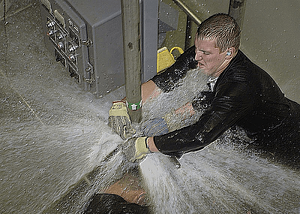“So Jeff…the real question is…how soon do you want to start saving money?” the salesman asked across my kitchen table. I looked up at him, then back down at the quote for the new household de-ionized soft water system, and then back at him. I hadn’t yet developed my professorial; is-that-really-all-you-got-glance-over-my-glasses-look yet but this was one of the moments that led to its development.
“So…Stan, after my $200 installation cost and $75 a month thereafter my net savings will still be…lemme see here….back page….the one with all the footnotes and fine print…”
“Ninety-two-fifty-six” Stan said as he pointed to the number on the quote.
“Because of the pipes” my voice bearing a nascent prodding tone.
“Yes! The pipes. They are corroding in the walls as we speak. And all the detergents and soaps you won’t have to buy, the finish on your cars you won’t have to replace…it all adds up over time!” Stan’s accountant-look was highly developed.
 Fast forward 10 years and $11,107.20 in unrealized savings (I also didn’t buy Microsoft at $30 a share) I heard these words “really…I don’t know why they want to put off saving money”. Stan?!? No, these words were spewing from my mouth in talking to a colleague about a client hesitating putting in a modern WFM system.
Fast forward 10 years and $11,107.20 in unrealized savings (I also didn’t buy Microsoft at $30 a share) I heard these words “really…I don’t know why they want to put off saving money”. Stan?!? No, these words were spewing from my mouth in talking to a colleague about a client hesitating putting in a modern WFM system.
“But look what they are spending, no!…WASTING now on their manual process” Bryan said “all that money down the drain each month!”
“You ever sell soft water systems, Bryan?” I asked.
“What?” Bryan said
“Never mind”, I said.
The fact is, it’s hard not to sound like a door-to-door salesman sometimes when talking about the ROI for workforce management and time & attendance systems like Kronos Workforce Central and ADP eTime (and related products) – even though we aren’t even in the business of selling them. I would argue that this is probably because it is one of the few IT automation projects that really does have reasonable and measurable returns on investment if not stone-cold payback in less than a year in many cases. I believe this aversion to large capitalization of PR/TK/WFM projects is due to two interrelated perceptions.
The first is that payroll, and thus payroll processing, is one of those inescapable ‘gotta do it no matter what’ things in business. Like death and taxes the rate will never drop to zero so why spend good money after bad trying.
The second perception is that if payroll is basically getting done now, how bad could it be? Or from an ROI perspective, we couldn’t possibly be wasting THAT much money so there surely couldn’t be THAT much money to save. This idea is fostered in looking at partial-picture benchmarks like burden rate and direct paycheck processing costs or comparing one company’s Timekeeping/PR contract with another.
Now this is a blog, not to mention one with ‘101’ in the title, so you must forgive the short treatment I am about to give this subject. I believe, however, we need to get back to some fundamentals in how we go about the business of paying people and measuring the true cost of doing it. So here we go:
#1: Get it RIGHT first. Error rates much past 3% and you are inviting EXPENSIVE trouble from the Department of Labor and Unions. (Note: If you are getting away with more than 3% it is like borrowing from the Mob..don’t do it)
#2: Emps and Sups tracking time. If it weren’t for the outrageous penalties for the above this would easily be the #1 area of return in most Time Keeping and WFM automation projects. Paying producers to manage the time accounting of yet other producers is a huge waste of direct productivity.
#3: Payroll people processing payroll. Having half an army of people to pay your army of people is a waste of money.
That’s it. Check this plumbing first and see how an improved TimeKeeping/WFM solution could improve these numbers. These are really what WFM/TimeKeeping systems are all about. Oh sure, you can make a lot of suds by tossing words like ‘Human Capital Management’ and ‘Metro Workforce Model’ into the mix but that will only add a fresh lemon scent to all the big dollars going down the drain. Hmmm... Maybe Stan had a point?!?
Are you preparing for an implementation or upgrade?
Download the Workforce Management Implementation Strategy White Paper.




Comments